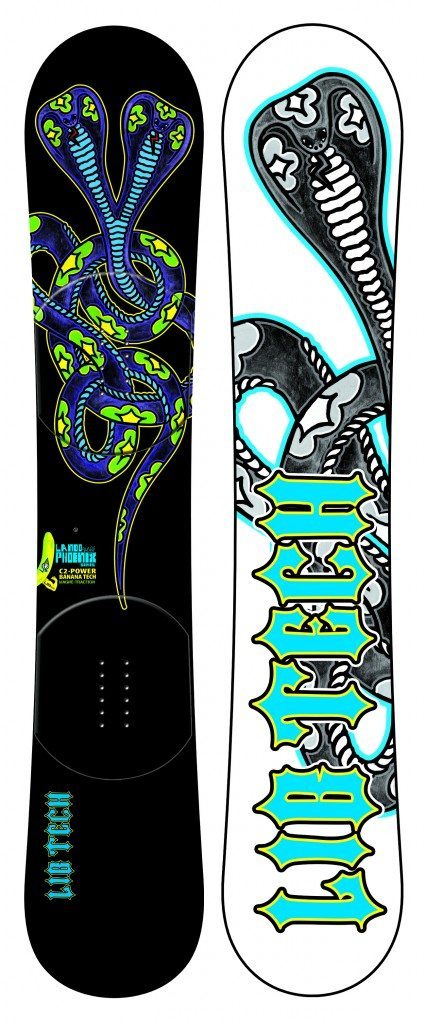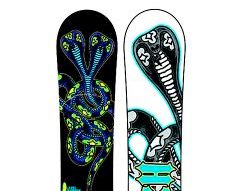Boots: K2 Thraxis
Bindings: K2 Auto Uprise
First things first: any board named after a ridiculous rider is going to get some attention. This is Mark Landvik’s pro model, a board for a guy who started heli-boarding at 16 and now spends his time cruising the world (Alaska and Patagonia anyone?) while trying to avoid avalanches (he was swept off a fifty-foot cliff by one this season).
The Lando is billed as an “All Mountain” plank, and it is packed full of the features that have driven snowboard innovation across the industry. This board has many features that are similar to those offered by competing manufacturers, but Lib Tech has themed their technology with consistency and artistry, not to mention pushing the development of the “strange.”
It’s easy to get confused by the Lib Tech terminology. For the purposes of this review, we are going to travel into the realm of, “What Can This Lunch Tray Do For You?” The Lando is certainly a board
that handles it all. But what does it handle best, and why?

Riding up the lift with a stranger at Snowbird, I was told the boards was “Easy on the eyes.” This really is a gorgeous board with graphics that look like DNA on acid, or love making snakes. Classic Lib Tech, at its best.
I was lucky to go to Snowbird to test this board and see how it handled the 3,000 ft per tram ride, with diverse terrain options available in every direction.
Day One: Up The Tram
This was my first time at the Bird, end of January, 2011. It hadn’t snowed in a while and some rain layers were lurking. Of course, when it’s blower powder, pretty much any snowboard will suffice, so the test conditions were perfect. We weren’t just riding deep powder, but a mix of pretty much everything: steep, sun affected faces; dry, packed chutes; icy, skied-off groomers; chattery, choppy run-outs; and yes, even stashes of untouched powder.
We used the first run to get our bearings and get used to the mountain. The plan was to board down the west side of the hill back to the tram. We headed toward Regulator Johnson, eager to open it up on a steep, open run. First turns on the Lando from the tram down the ridge were quick, responsive, and damp. This board is pretty dang stiff and very solid feeling underfoot. The sidecut of the board could be compared to a serrated knife cutting ice: there’s a little grind to it, and it is apparent that these serrations (Lib Tech calls it, “Magne-Traction”) enhances speed control – you don’t have to make as many checks or turns as you might on a board with traditional edges.
So what’s the Take Home Point with Magne-Traction? The serrated edge encourages tight radius turns and works to check speed – the rider definitely feels the grind. In my opinion, the Magne-Traction was too much. I’d rather have a smooth edge that allows me to go mach when I want to and check speed only when I have to. My style tends to be geared toward fast, big mountain tree and mogul charging, and the Magne-Traction seems a bit at odds with this type of riding. (Ok, now back to Regulator Johnson….)
Regulator Johnson was a slick slider slope and a wee bit sun affected already. I opened up some wide, huge carves on a very steep open run. I’m impressed by the Lando’s edge hold! I notice off to the left some moguls and a gate with two diamonds on it. I didn’t know where I was going, but those diamonds usually point to areas where you can get loose! I chop through some crud, trying to dig and ride fall line edge at speed to gage the chatter. I did notice some heel edge chatter issues, as if the board was so stiff it wasn’t dampening the bumps. This seemed somewhat contradictory because stiffer usually means more stable. However, snowboards have to be torsionally dynamic to accommodate heel-toe flexing changes. But I wasn’t reading too much into this since I’d only been on the board for a few minutes and there are always stance issues to work out before getting it right.

